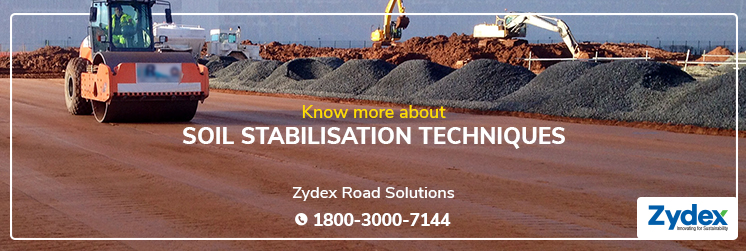The role of soil is crucial for the design and construction of any structure, be it roads, runways or railway tracks. This is because it acts as the medium for effective load transfer in to the earth. This implies that a weak soil base will eventually cause settlement of the structure, leading to failure.
Stabilisation is the process of improving the engineering properties of the soil before construction. Stabilisation is done to improve the strength of the soil and shrink/arrest the swelling potential, thus improving the load bearing capacity and the overall performance of the in-situ soils.
There are 3 main methods for soil stabilisation:
1. Mechanical stabilisation
This category consists of physical processes such as compacting or tamping with machineries including rollers or rammers. The mechanical soil stabilisation is also achieved by blending (adding or removing) different soil particles so as to obtain effective distribution of soil particle. These techniques are usually used for sub-base and base courses.
2. Chemical Stabilisation
As the name suggests, stabilisation of soils depends on the chemical reaction between the chemical/stabiliser used and the soil particle composition. These include, Cement, Lime, Magnesium Chloride, Bitumen Emulsion and Fly Ash among others.
Traditionally and widely practiced type of soil stabilisation techniques include:
i. Bitumen Emulsion
Bitumen emulsion is used as a binding agent both cohesive as well as non-cohesive soils. However, in soils with finer grain sizes, this method may no longer be cost effective as the soil particles require a high dosage of bitumen emulsion in order to provide the same/better level of bonding. Bitumen emulsion is not environmentally friendly and becomes brittle when it dries, which affects the stability of the soil.
ii. Cement/Lime
Cement/Lime is widely used as a soil stabilising agent. Addition of cement to soil improves the strength of the soil. It is used for the sub-base and base courses of all types of pavement. However, due to the consequent wet and dry cycles, there occurs a degradation of the bonding between the cement and soil particles. Also, this is a very costly in terms of financial viability. Lime stabilisation improves the strength of the soil by imparting increased bonding between the lime and soil particles. This method is cost effective as compared to cement stabilisation.
iii. Apart from the above mentioned stabilising agents, some other alternatives currently in practice include Fly Ash, Cement Kiln Dust (CKD), Tree Resin and Ionic Stabilizers.
3. Polymer Stabilisation
Polymer soil stabilization refers to the addition of polymers to improve the physical & engineering properties of soils (Polymer Soil Stabilisation, 2019).
Polymers tend to increase the strength of the soil through their interaction with clayey particles present in the soil. Many polymers currently used, tend to increase the water retention capability and the shear strength of the soil.
Polymers used for soil stabilisation can be classified into two main categories viz. Biopolymers and Synthetic Polymers. Biopolymers are eco-friendly as compared to other chemical soil stabilisers.







